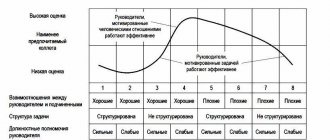In real life, sometimes it is not so easy to establish the true cause of a conflict. And without this, it is impossible to find the optimal solution to pay it off. It is for such difficult cases that it is useful to know the styles of behavior in conflict that interlocutors can use. Depending on the circumstances, it is necessary to choose a certain strategy of action. You will learn what to do in this or that situation in the article.
Basic behavior patterns in conflict
The predictive style is characterized by the avoidance of unwanted conflicts. A person with such a model of behavior tries not to succumb to provocations. He will first analyze the dangerous areas and weigh the pros and cons. If conflict is the only way out of the situation, he will decide to start a dispute. With a predictive model, you think through all the options for your actions and calculate the possible actions of your interlocutor. This style of behavior in conflict is characterized by the absence of emotional reactions or their weak expression. The most preferable outcome is a compromise.
The corrective style can be characterized by a lag in assessing the situation. That is why reactions to disagreements arise immediately - immediately after the conflict begins. At the same time, a person with such a model of behavior does not believe that there is a problem, but behaves very emotionally and unrestrainedly. Actions are characterized by fussiness, especially at the beginning of the conflict.
The destructive style is characterized by the denial of the possibility of mutual concessions. Compromise is seen only as a sign of weakness. Therefore, such a way out of the situation is considered unacceptable. A person with such a model of behavior constantly emphasizes the fallacy of his opponent’s positions and his own rightness. In this case, the interlocutor is accused of malicious intent, selfish motives and personal interest. A controversial situation with this method of behavior will be perceived extremely emotionally by both parties.
These were the main styles of behavior in conflict. Within them, strategies can be distinguished.
Advantages of passive and active strategies
How to manipulate people - can this be learned, methods of influence
Rivalry is a manifestation of activity. The main advantage is that a person can defend his point of view and achieve the desired result. When choosing this strategy, you need to be aware that relations with your opponent may deteriorate. Rivalry is appropriate in relations between management and subordinates, between employees, but not in family matters.
Compromise, accommodation, cooperation and avoidance are passive ways of behaving in interpersonal conflict. The main advantages are the ability to maintain human relationships and partially achieve the goal. The strategies are appropriate to use in business, among family and friends.
Cooperation
This is the most difficult behavior model, but at the same time the most effective of all. Its point is to find a solution that would satisfy the interests and needs of all parties to the conflict. To do this, everyone’s opinion is taken into account and all proposed options are listened to. The discussion takes place calmly, without negative emotions. Conversation uses evidence, arguments, and persuasion to achieve results. This style of behavior in resolving conflict is based on mutual respect and therefore contributes to the maintenance of strong and long-lasting relationships.
However, you need to be able to restrain your emotions, clearly explain your interests and listen to the other side. The absence of at least one factor makes this behavior model ineffective. In what situations is this style most appropriate?
- When compromise is not suitable, but a common solution is needed.
- If the main goal is joint work experience.
- There is an interdependent and long-term relationship with the conflicting party.
- It is necessary to exchange points of view and strengthen the personal involvement of opponents in the activity.
What is meant by a conflict situation?
A conflict situation is a lack of agreement between the parties, arising due to opposing values, interests, judgments and goals of the parties.
It is generally accepted that a conflict is necessarily accompanied by open opposition from its participants, quarrels, negative emotions, etc. But this is not always the case. The process of solving a problem and its outcome depend on the correctly chosen strategy of behavior.
Compromise
This is a less constructive style of behavior in conflict. Compromise nevertheless occurs, especially when it is necessary to quickly relieve accumulated tension and resolve a dispute. The model resembles “collaboration”, but is carried out at a superficial level. Each side is inferior to the other in some way. Therefore, as a result of a compromise, the interests of opponents are partially satisfied. Reaching a common solution requires effective communication skills.
In what cases is compromise effective?
- When the interests of both parties cannot be fulfilled at the same time. For example, opponents are applying for one position.
- If it is more important to win something than to lose everything.
- The interlocutors have equal power and present equally convincing arguments. Then cooperation gives way to compromise.
- A temporary solution is needed because there is no time to find another one.
Ignoring
This style of behavior of people in conflict is characterized by a conscious or unconscious avoidance of sorting out the relationship. A person who has chosen this strategy tries not to get into unpleasant situations. If they arise, he simply avoids discussing decisions that are fraught with disagreement. The most common is unconscious ignoring, which is a defense mechanism of the psyche.
Some people use this model quite deliberately, and this is a justified move. Ignoring is not always an evasion of responsibility or an escape from a problem. This deferment may be an appropriate solution for certain situations.
- If the problem that has arisen is not important for the party, and there is no point in defending your rights.
- There is no time and energy to find the optimal solution. You can return to the conflict later, or it will resolve itself.
- The opponent has great power, or the other interlocutor feels that he is in the wrong.
- If there is a possibility that dangerous details will be revealed during the discussion, after which the disagreement will only intensify.
- Other styles of behavior in conflict turned out to be ineffective.
- Relationships are short-lived or unpromising; there is no need to maintain them.
- The interlocutor is a conflict person (rude, complainant, etc.). Sometimes it is better not to have a dialogue with such people.
Hard Tactics
Tactics in a conflict situation are a set of techniques for influencing an opponent in a conflict, methods for implementing behavioral strategies.
There are hard, neutral and soft tactics of behavior.
As the conflict escalates, as a rule, they move from soft to hard.
In addition, there are rational , for example, friendliness, justification of one’s own position, and irrational, pressure or psychological violence, tactics.
Hard tactics include:
- capture and retention of the conflict object .
This tactic is used if the object of the conflict is material. It includes physical impact, infliction of pain, and blocking the opponent’s actions. - psychological abuse. This is an insult to the opponent, deception, control over behavior, humiliation, authoritarianism and dictatorship in relationships,
- psychological pressure. This includes blackmail, presentation of demands, even ultimatums.
Rivalry
This strategy is typical for most people, in which the interlocutor tries to pull the blanket to his side. Only their own interests are valued, other people's needs are not taken into account, and opinions and arguments are simply ignored. The competing party is trying to force people to accept their point of view in every possible way.
Position and power can even be used for coercion in this style of behavior. Participants in the conflict representing the opponent are often not satisfied with the solution, and they may sabotage it or abandon the relationship. Therefore, competition is ineffective and rarely fruitful. Moreover, the decision made in most cases turns out to be incorrect, since other people’s opinions are not taken into account. When is competition effective in conflict?
- When there is authority and sufficient power, and the proposed solution seems obvious and the most correct.
- There is no other choice and nothing to lose.
- If the interlocutors (often subordinates) prefer an authoritarian style of communication.
Styles
In psychology, it is customary to distinguish 6 styles:
- Affiliate. Characteristic of long-term relationships where both opponents know each other well and want to maintain mutual understanding and trust.
- Pragmatic. Suitable for situations where the relationship with a person is not important. It is more important to push the conflict away from yourself.
- Psychoprotective. The goal is to maintain internal harmony. It arises where the mutually exclusive interests of opponents are noticeable.
- Dominant. One or both participants behave selfishly, aggressively, or violate social norms.
- Contact. One person behaves as contactably as possible, trying to find out as much as possible about the opponent in order to then control him.
- Self-affirming. One person is trying to “break” the other so that he himself gives up the confrontation.
The first 3 styles relate to constructive conflict resolution, the last 3 to destructive ones.
Device
This strategy is characterized by giving up the fight and changing one’s own position. The situation is smoothed out by the compliance of the opponent, who believes that it is better to preserve the relationship than to quarrel and achieve what is right. With this style of behavior of the parties, the conflict is forgotten, but sooner or later it will make itself felt. There is no need to give up your interests. You can return to discussing the problem after some time and try to find a solution in a more favorable environment.
In what situations is it better to make concessions?
- When the needs of another person seem more important, and his feelings about this are very strong.
- The subject of disagreement is not significant.
- If the priority is to maintain good relationships rather than defend your opinion.
- There is a feeling that there is not enough chance to convince the interlocutor that you are right.
Types of people in conflicts
The style of behavior in conflict situations can be viewed from a slightly different angle. Psychologists also identify types of “difficult” people that you may encounter in a controversial situation.
"Steam boiler". These are unceremonious and very rude people who are afraid of losing authority and believe that everyone should agree with them. If it is not so important to win the argument, then it is better to concede. Otherwise, you first need to wait for the person to let off steam, and only then stand up for what’s right.
"Explosive Child" Such people are not evil by nature, but are extremely emotional. They can be compared to babies who are in a bad mood. The best solution would be to let someone shout out, and then calm the interlocutor and move on to finding a solution.
"Complainers." They complain about realistic or imaginary circumstances. It is better to listen to such people first, and then repeat the essence in his own words, thus showing your interest. After this, you can deal with the conflict. If your opponent still continues to complain, then the optimal solution is to adopt a strategy of ignoring.
"Non-conflict." Such people always give in to please others. But words may differ from deeds. Therefore, the emphasis should be placed not on agreement with the decision, but on the fact that the opponent will keep his promise.
"The silent ones." Usually these are extremely secretive people who are difficult to bring into dialogue. If avoiding the problem is not an option, then you need to try to overcome your opponent’s isolation. To do this, you need to reveal the essence of the conflict by asking only open questions. You may even have to be a little persistent to keep the conversation going.
Conflict situations at work
During the work process, colleagues often have misunderstandings both on work-related issues and as a result of personal disagreements.
Employee - employee
In conflict situations with colleagues of your rank, any of five strategies will be suitable, depending on the situation. But still, rivalry is best used as a last resort. If disagreements relate to work issues, it would be wiser to negotiate with your opponent to come to a compromise solution. It is important to express your point of view, since you and your opponent are on equal terms. Evasion and adaptation in most matters will not be justified.
To avoid conflicts related to personal relationships, it is important to remember that during working hours you need to primarily focus on fulfilling your duties, leaving personal communication for a while after work. Of course, personal communication is necessary, and it will be present in any case. But gossip and conversations on too personal topics should not be supported.










